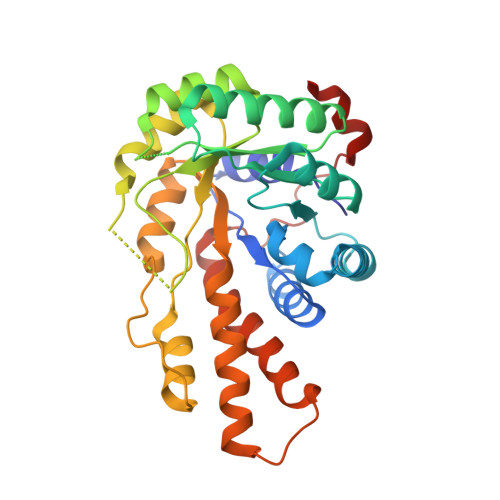Characterization, kinetics, and crystal structures of fructose-1,6-bisphosphate aldolase from the human parasite, Giardia lamblia.
Galkin, A., Kulakova, L., Melamud, E., Li, L., Wu, C., Mariano, P., Dunaway-Mariano, D., Nash, T.E., Herzberg, O.(2007) J Biol Chem 282: 4859-4867
- PubMed: 17166851
- DOI: https://doi.org/10.1074/jbc.M609534200
- Primary Citation of Related Structures:
2ISV, 2ISW - PubMed Abstract:
Class I and class II fructose-1,6-bisphosphate aldolases (FBPA), glycolytic pathway enzymes, exhibit no amino acid sequence homology and utilize two different catalytic mechanisms. The mammalian class I FBPA employs a Schiff base mechanism, whereas the human parasitic protozoan Giardia lamblia class II FBPA is a zinc-dependent enzyme. In this study, we have explored the potential exploitation of the Giardia FBPA as a drug target. First, synthesis of FBPA was demonstrated in Giardia trophozoites by using an antibody-based fluorescence assay. Second, inhibition of FBPA gene transcription in Giardia trophozoites suggested that the enzyme is necessary for the survival of the organism under optimal laboratory growth conditions. Third, two crystal structures of FBPA in complex with the transition state analog phosphoglycolohydroxamate (PGH) show that the enzyme is homodimeric and that its active site contains a zinc ion. In one crystal form, each subunit contains PGH, which is coordinated to the zinc ion through the hydroxamic acid hydroxyl and carbonyl oxygen atoms. The second crystal form contains PGH only in one subunit and the active site of the second subunit is unoccupied. Inspection of the two states of the enzyme revealed that it undergoes a conformational transition upon ligand binding. The enzyme cleaves d-fructose-1,6-bisphosphate but not d-tagatose-1,6-bisphosphate, which is a tight binding competitive inhibitor. The essential role of the active site residue Asp-83 in catalysis was demonstrated by amino acid replacement. Determinants of catalysis and substrate recognition, derived from comparison of the G. lamblia FBPA structure with Escherichia coli FBPA and with a closely related enzyme, E. coli tagatose-1,6-bisphosphate aldolase (TBPA), are described.
Organizational Affiliation:
Center for Advanced Research in Biotechnology, University of Maryland Biotechnology Institute, Rockville, Maryland 20850.
















